
After my first year working as the Director of Faith Formation, I realized that I had spent very little time focusing on Christian service with my students. Though service has been a great influence on my own faith, with our calendar already packed with so much curriculum to cover, service seemed like something extra—something nice to have if we could find the time. The Year of Mercy, however, offers catechists a unique opportunity to be intentional about guiding students to understand that they are called to share God’s mercy. Below are five ideas to include the Year of Mercy in your classroom or program.
1. Introduce students to the Year of Mercy by reading the parable of the Good Shepherd. Have students draw a picture of the scene when the Shepherd finds his sheep. Connect these pictures to the official Year of Mercy logo, and hang all of the images around the room as a reminder that we are called to be merciful as our Heavenly Father is merciful.
2. Focus on practicing one of the works of mercy each month, alternating between the spiritual and corporal works of mercy. Plan an activity or event that students and families from all grades and the entire parish could participate in. Canned food and clothing drives, nursing home visits, and sending cards to prisoners are all projects that are relatively easy to plan. They offer great teaching moments on how our small acts of kindness make a big difference.
3. Incorporate saints and holy people who were known for practicing the works of mercy into your lessons and class prayers. St. Vincent de Paul, Dorothy Day, and St. Catherine of Siena are just a few people whose life stories may help students understand how we are called to live our lives in service to others. Adopt one of these holy men or women as your class’s patron saint for the year.
4. Offer opportunities for students to celebrate the Sacrament of Penance and Reconciliation. We receive God’s love and forgiveness when we celebrate this sacrament. Dedicate a class where you prepare for and celebrate Reconciliation, or plan an evening for families to come for a penance service. Although they may be nervous, children will appreciate the chance to experience God’s mercy firsthand.
5. Record all the ways your class serves others throughout the year. After the Year of Mercy concludes in November, compile any stories and pictures you may have and share them with your parish. It will be amazing to look back at the ways that your students have shared God’s mercy with others.
The Year of Mercy is a beautiful time to align our words and actions with those of Christ, who did his Father’s will in all things. As St. Teresa of Ávila said, “Christ has no body but ours.” Let us work together to share God’s mercy through our words and actions, and may we empower those we catechize to do the same.
How will you include the Year of Mercy in your classroom?
For more ideas, download the Works of Mercy Prayers and Activities—Free Resource Packet Perfect for the Year of Mercy.





Be the first to comment